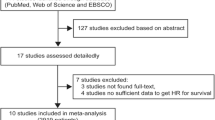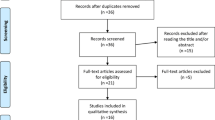Abstract
Purpose
The systemic inflammatory response markers have been reported to be associated with the prognosis of various cancers. We conducted this meta-analysis of retrospective studies to evaluate and identify the prognostic impact of neutrophil to lymphocyte ratio (NLR) and platelet to lymphocyte ratio (PLR) on ovarian cancer.
Methods
PubMed, EMBASE, and China National Knowledge Infrastructure databases were included to search for eligible studies. The following terms were used: “neutrophil to lymphocyte ratio”, “NLR”, “platelet to lymphocyte ratio”, “PLR”, “ovarian cancer”, “ovary cancer”, “ovarian carcinoma”, “ovary carcinoma”, “ovarian neoplasm”, “ovary neoplasm”, “ovarian tumor”, and “ovary tumor”. The random-effects model was chosen to estimate the pooled HR with 95% CI. Heterogeneity between studies was assessed by Higgins I2 value. The stability and heterogeneity of studies were analyzed by sensitivity analysis. Publication bias was examined by Egger’s test and Begg’s test with the funnel plots.
Results
13 studies consisting of 3467 patients were considered for meta-analysis. We found that the high NLR had a poor prognostic impact on OS and PFS in ovarian cancer, with a pooled HR 1.70, 95% CI 1.35–2.15 and HR 1.77, 95% CI 1.48–2.12, respectively. Similarly, the results showed the high PLR adversely affected OS and PFS in ovarian cancer, with a pooled HR 2.05, 95% CI 1.70–2.48 and HR 1.85, 95% CI 1.53–2.25, respectively.
Conclusion
In conclusion, we found that both NLR and PLR had an unfavorable impact on PFS and OS of patients with ovarian cancer. Our meta-analysis supported that NLR/PLR could be effective prognostic predictors of ovarian cancer.





Similar content being viewed by others
References
Siegel RL, Miller KD, Jemal A (2016) Cancer statistics, 2016. CA Cancer J Clin 66(1):7–30. https://doi.org/10.3322/caac.21332
Berek JS, Crum C, Friedlander M (2015) Cancer of the ovary, fallopian tube, and peritoneum. Int J Gynaecol Obstet 131(Suppl 2):S111–S122. https://doi.org/10.1016/j.ijgo.2015.06.007
Jia H, Zhang Q, Liu F, Zhou D (2017) Prognostic value of MMP-2 for patients with ovarian epithelial carcinoma: a systematic review and meta-analysis. Arch Gynecol Obstet 295(3):689–696. https://doi.org/10.1007/s00404-016-4257-9
Kucukgoz Gulec U, Gumurdulu D, Guzel AB, Paydas S, Seydaoglu G, Acikalin A, Khatib G, Zeren H, Vardar MA, Altintas A (2014) Prognostic importance of survivin, Ki-67, and topoisomerase IIα in ovarian carcinoma. Arch Gynecol Obstet 289(2):393–398. https://doi.org/10.1007/s00404-013-3000-z
Hanahan D, Weinberg RA (2011) Hallmarks of cancer: the next generation. Cell 144(5):646–674. https://doi.org/10.1016/j.cell.2011.02.013
Hainaut P, Plymoth A (2013) Targeting the hallmarks of cancer: towards a rational approach to next-generation cancer therapy. Curr Opin Oncol 25(1):50–51. https://doi.org/10.1097/CCO.0b013e32835b651e
Jaiswal M, LaRusso NF, Burgart LJ, Gores GJ (2000) Inflammatory cytokines induce DNA damage and inhibit DNA repair in cholangiocarcinoma cells by a nitric oxide-dependent mechanism. Can Res 60(1):184–190
Templeton AJ, Ace O, McNamara MG, Al-Mubarak M, Vera-Badillo FE, Hermanns T, Seruga B, Ocana A, Tannock IF, Amir E (2014) Prognostic role of platelet to lymphocyte ratio in solid tumors: a systematic review and meta-analysis. Cancer Epidemiol Biomark Prev Publ Am Assoc Cancer Res Cospons Am Soc Prev Oncol 23(7):1204–1212. https://doi.org/10.1158/1055-9965.epi-14-0146
Templeton AJ, McNamara MG, Seruga B, Vera-Badillo FE, Aneja P, Ocana A, Leibowitz-Amit R, Sonpavde G, Knox JJ, Tran B, Tannock IF, Amir E (2014) Prognostic role of neutrophil-to-lymphocyte ratio in solid tumors: a systematic review and meta-analysis. J Natl Cancer Inst 106(6):dju124. https://doi.org/10.1093/jnci/dju124
Miao Y, Yan Q, Li S, Li B, Feng Y (2016) Neutrophil to lymphocyte ratio and platelet to lymphocyte ratio are predictive of chemotherapeutic response and prognosis in epithelial ovarian cancer patients treated with platinum-based chemotherapy. Cancer Biomark Sect A Dis Markers 17(1):33–40. https://doi.org/10.3233/cbm-160614
Eo WK, Chang HJ, Kwon SH, Koh SB, Kim YO, Ji YI, Kim HB, Lee JY, Suh DS, Kim KH, Chang IJ, Kim HY, Chang SC (2016) The lymphocyte–monocyte ratio predicts patient survival and aggressiveness of ovarian cancer. J Cancer 7(3):289–296. https://doi.org/10.7150/jca.13432
Cho H, Hur HW, Kim SW, Kim SH, Kim JH, Kim YT, Lee K (2009) Pre-treatment neutrophil to lymphocyte ratio is elevated in epithelial ovarian cancer and predicts survival after treatment. Cancer Immunol Immunother 58(1):15–23. https://doi.org/10.1007/s00262-008-0516-3
Asher V, Lee J, Innamaa A, Bali A (2011) Preoperative platelet lymphocyte ratio as an independent prognostic marker in ovarian cancer. Clin Transl Oncol 13(7):499–503. https://doi.org/10.1007/s12094-011-0687-9
Thavaramara T, Phaloprakarn C, Tangjitgamol S, Manusirivithaya S (2011) Role of neutrophil to lymphocyte ratio as a prognostic indicator for epithelial ovarian cancer. J Med Assoc Thail (Chotmaihet Thangphaet) 94(7):871–877
Raungkaewmanee S, Tangjitgamol S, Manusirivithaya S, Srijaipracharoen S, Thavaramara T (2012) Platelet to lymphocyte ratio as a prognostic factor for epithelial ovarian cancer. J Gynecol Oncol 23(4):265–273. https://doi.org/10.3802/jgo.2012.23.4.265
Williams KA, Labidi-Galy SI, Terry KL, Vitonis AF, Welch WR, Goodman A, Cramer DW (2014) Prognostic significance and predictors of the neutrophil-to-lymphocyte ratio in ovarian cancer. Gynecol Oncol 132(3):542–550. https://doi.org/10.1016/j.ygyno.2014.01.026
Wang Y, Liu P, Xu Y, Zhang W, Tong L, Guo Z, Ni H (2015) Preoperative neutrophil-to-lymphocyte ratio predicts response to first-line platinum-based chemotherapy and prognosis in serous ovarian cancer. Cancer Chemother Pharmacol 75(2):255–262. https://doi.org/10.1007/s00280-014-2622-6
Zhang W, Liu K, Hu G, Liang W (2015) Preoperative platelet/lymphocyte ratio is a superior prognostic factor compared to other systemic inflammatory response markers in ovarian cancer patients. Tumor Biol 36(11):8831–8837. https://doi.org/10.1007/s13277-015-3533-9
Feng Z, Wen H, Bi R, Ju X, Chen X, Yang W, Wu X (2016) Preoperative neutrophil-to-lymphocyte ratio as a predictive and prognostic factor for high-grade serous ovarian cancer. PLoS One 11(5):e0156101. https://doi.org/10.1371/journal.pone.0156101
Kim HS, Choi HY, Lee M, Suh DH, Kim K, No JH, Chung HH, Kim YB, Song YS (2016) Systemic inflammatory response markers and CA-125 levels in ovarian clear cell carcinoma: a two center cohort study. Cancer Res Treat 48(1):250–258. https://doi.org/10.4143/crt.2014.324
Wang YQ, Jin C, Zheng HM, Zhou K, Shi BB, Zhang Q, Zheng FY, Lin F (2016) A novel prognostic inflammation score predicts outcomes in patients with ovarian cancer. Clin Chim Acta Int J Clin Chem 456:163–169. https://doi.org/10.1016/j.cca.2016.03.013
Xin W, Hong Z (2016) The prognostic value of pretreatment serum NLR and PLR in epithelial ovarian cancer. Prog Obstet Gynecol 25(06):4
Tierney JF, Stewart LA, Ghersi D, Burdett S, Sydes MR (2007) Practical methods for incorporating summary time-to-event data into meta-analysis. Trials 8:16
Higgins JP, Thompson SG (2002) Quantifying heterogeneity in a meta-analysis. Stat Med 21(11):1539–1558. https://doi.org/10.1002/sim.1186
Balkwill F, Mantovani A (2001) Inflammation and cancer: back to Virchow? Lancet 357(9255):539–545. https://doi.org/10.1016/S0140-6736(00)04046-0
Grivennikov SI, Greten FR, Karin M (2010) Immun Inflamm Cancer. Cell 140(6):883–899. https://doi.org/10.1016/j.cell.2010.01.025
Swann JB, Vesely MD, Silva A, Sharkey J, Akira S, Schreiber RD, Smyth MJ (2008) Demonstration of inflammation-induced cancer and cancer immunoediting during primary tumorigenesis. Proc Natl Acad Sci USA 105(2):652–656. https://doi.org/10.1073/pnas.0708594105
Lin WW, Karin M (2007) A cytokine-mediated link between innate immunity, inflammation, and cancer. J Clin Investig 117(5):1175–1183. https://doi.org/10.1172/jci31537
Kusumanto Y, Dam W, Hospers G, Meijer C, Mulder N (2003) Platelets and granulocytes, in particular the neutrophils, form important compartments for circulating vascular endothelial growth factor. Angiogenesis 6(4):283–287
Hagerling C, Casbon A-J, Werb Z (2015) Balancing the innate immune system in tumor development. Trends Cell Biol 25(4):214–220. https://doi.org/10.1016/j.tcb.2014.11.001
Murray PJ, Allen JE, Biswas SK, Fisher EA, Gilroy DW, Goerdt S, Gordon S, Hamilton JA, Ivashkiv LB, Lawrence T, Locati M, Mantovani A, Martinez FO, Mege J-L, Mosser DM, Natoli G, Saeij JP, Schultze JL, Shirey KA, Sica A, Suttles J, Udalova I, van Ginderachter JA, Vogel SN, Wynn TA (2014) Macrophage activation and polarization: nomenclature and experimental guidelines. Immunity 41(1):14–20. https://doi.org/10.1016/j.immuni.2014.06.008
Pillay J, Tak T, Kamp VM, Koenderman L (2013) Immune suppression by neutrophils and granulocytic myeloid-derived suppressor cells: similarities and differences. Cell Mol Life Sci 70(20):3813–3827. https://doi.org/10.1007/s00018-013-1286-4
Walker JA, Barlow JL, McKenzie AN (2013) Innate lymphoid cells—how did we miss them? Nat Rev Immunol 13(2):75–87. https://doi.org/10.1038/nri3349
Gabrilovich DI, Nagaraj S (2009) Myeloid-derived suppressor cells as regulators of the immune system. Nat Rev Immunol 9(3):162–174. https://doi.org/10.1038/nri2506
Coussens LM, Werb Z (2002) Inflammation and cancer. Nature 420(6917):860–867. https://doi.org/10.1038/nature01322
Hanahan D, Weinberg RA (2000) The hallmarks of cancer. Cell 100(1):57–70
Lin EY, Pollard JW (2004) Role of infiltrated leucocytes in tumour growth and spread. Br J Cancer 90(11):2053–2058. https://doi.org/10.1038/sj.bjc.6601705
Dunn GP, Old LJ, Schreiber RD (2004) The immunobiology of cancer immunosurveillance and immunoediting. Immunity 21(2):137–148. https://doi.org/10.1016/j.immuni.2004.07.017
Fumagalli LA, Vinke J, Hoff W, Ypma E, Brivio F, Nespoli A (2003) Lymphocyte counts independently predict overall survival in advanced cancer patients: a biomarker for IL-2 immunotherapy. J Immunother 26(5):394–402
Fogar P, Sperti C, Basso D, Sanzari MC, Greco E, Davoli C, Navaglia F, Zambon CF, Pasquali C, Venza E, Pedrazzoli S, Plebani M (2006) Decreased total lymphocyte counts in pancreatic cancer: an index of adverse outcome. Pancreas 32(1):22–28
Blake-Mortimer JS, Sephton SE, Carlson RW, Stites D, Spiegel D (2004) Cytotoxic T lymphocyte count and survival time in women with metastatic breast cancer. Breast J 10(3):195–199. https://doi.org/10.1111/j.1075-122X.2004.21290.x
Smith RA, Ghaneh P, Sutton R, Raraty M, Campbell F, Neoptolemos JP (2008) Prognosis of resected ampullary adenocarcinoma by preoperative serum CA19-9 levels and platelet-lymphocyte ratio. J Gastrointest Surg 12(8):1422–1428. https://doi.org/10.1007/s11605-008-0554-3
Wang D, Yang JX, Cao DY, Wan XR, Feng FZ, Huang HF, Shen K, Xiang Y (2013) Preoperative neutrophil-lymphocyte and platelet-lymphocyte ratios as independent predictors of cervical stromal involvement in surgically treated endometrioid adenocarcinoma. OncoTargets Ther 6:211–216. https://doi.org/10.2147/ott.s41711
Alexandrakis MG, Passam FH, Moschandrea IA, Christophoridou AV, Pappa CA, Coulocheri SA, Kyriakou DS (2003) Levels of serum cytokines and acute phase proteins in patients with essential and cancer-related thrombocytosis. Am J Clin Oncol 26(2):135–140. https://doi.org/10.1097/01.coc.0000017093.79897.de
Suzuki K, Aiura K, Ueda M, Kitajima M (2004) The influence of platelets on the promotion of invasion by tumor cells and inhibition by antiplatelet agents. Pancreas 29(2):132–140
Allensworth SK, Langstraat CL, Martin JR, Lemens MA, McGree ME, Weaver AL, Dowdy SC, Podratz KC, Bakkum-Gamez JN (2013) Evaluating the prognostic significance of preoperative thrombocytosis in epithelial ovarian cancer. Gynecol Oncol 130(3):499–504. https://doi.org/10.1016/j.ygyno.2013.05.038
Author information
Authors and Affiliations
Contributions
ZZ: Project development, Data collection, Manuscript writing. XZ: Data collection, Data analysis. JX: Data analysis. JL: Data collection, Data analysis. PL: Manuscript writing.
Corresponding authors
Ethics declarations
Conflict of interest
The authors have declared that no conflict of interest exists.
Ethical approval
This article does not contain any studies with human participants performed by any of the authors.
Electronic supplementary material
Below is the link to the electronic supplementary material.
404_2018_4678_MOESM1_ESM.tif
Publication bias of meta analysis between included studies. A: NLR and OS; B: NLR and PFS; C: PLR and OS; D: PLR and PFS (TIFF 14038 kb)
Rights and permissions
About this article
Cite this article
Zhao, Z., Zhao, X., Lu, J. et al. Prognostic roles of neutrophil to lymphocyte ratio and platelet to lymphocyte ratio in ovarian cancer: a meta-analysis of retrospective studies. Arch Gynecol Obstet 297, 849–857 (2018). https://doi.org/10.1007/s00404-018-4678-8
Received:
Accepted:
Published:
Issue Date:
DOI: https://doi.org/10.1007/s00404-018-4678-8




